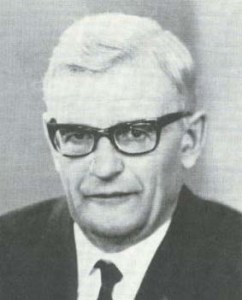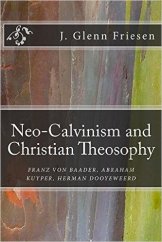
The Christian philosophy of the Dutch philosopher Herman Dooyeweerd (pronounced “Do-yuh-veerd,” with a long vowel ‘o’) is not widely known in the English-speaking world. Those who do know about his philosophy have often downplayed or rejected its mystical basis. As a result, I believe that Dooyeweerd’s philosophy has been seriously misunderstood and misinterpreted. But when his philosophy is understood, it has an exciting new relevance to today’s issues regarding the nature of our experience to our theoretical understanding as well as to our deepest religious motives.
Herman Dooyeweerd (1894-1977)
Photo around 1960 from The Legacy of Herman Dooyeweerd
Books and Articles by Dooyeweerd.
Hypertext Translation of Excerpts from Herman Dooyeweerd: The Philosophy of the Law-Idea (Amsterdam: H.J. Paris, 1935-36)
Many of Dooyeweerd’s works can be found in the above List of Books and Articles by Dooyeweerd. This includes links to an online version of his major work A New Critique of Theoretical Thought (1953-55), which was a translation and revision of his work De Wijsbegeerte der Wetsidee (1935-36) [WdW]. However, that translation was not done in a a consistent way, and some of the meanings of the original Dutch are not always made clear. Furthermore, many important parts of the WdW were not included in A New Critique of Theoretical Thought. I have therefore included my own translations of substantial portions of the WdW. When you read Dooyeweerd, read slowly and carefully, even meditatively. Do not assume that you know the meaning of the words that he uses, even if those words look familiar! I have included a Linked Glossary of terms, and I have linked my translations to that Glossary.
I have also published many articles about Dooyeweerd and his philosophy. They can be downloaded from this List of My Articles on Dooyeweerd.

See also my recent book, examining the sources and development of Dooyeweerd’s philosophy:
Neo-Calvinism and Christian Theosophy: Franz von Baader, Abraham Kuyper, Herman Dooyeweerd (Calgary: Aevum Books, 2015), available at Amazon and other bookstores.
A Christian worldview, the idea of sphere sovereignty, opposition to the autonomy of thought, a Free University, our supratemporal selfhood–these and other key ideas of neo-Calvinism all find their source in the Christian theosophy of Franz von Baader. This book traces the history of these ideas from Baader to Chantepie de la Saussaye to Gunning to Kuyper and to Dooyeweerd.
Dooyeweerd called his philosophy “The Philosophy of the Law-Idea.” In English, his philosophy has also been referred to as the Philosophy of the Cosmonomic Idea (The Idea of the Law of the Cosmos). And because of its association with neo-Calvinism, and the ideas of Abraham Kuyper, this philosophy has also sometimes been referred to as “Calvinistic Philosophy.” But Dooyeweerd distanced himself from the term ‘Calvinistic’, saying that his philosophy deserved to be known as simply ‘Christian Philosophy.’ He took a much more ecumenical view of his philosophy. I believe that Dooyeweerd’s philosophy can best be understood as “Christian Nondualism.” This is not a term that he himself used. But his philosophy rejects all dualistic Ground Motives in favour of an integral Ground Motive of creation, fall and redemption. To emphasize nondualism shows the contrast between his philosophy and the dualistic philosophies that he rejects.
If you have not read Dooyeweerd before, try reading his own article, “Introduction to a Transcendental Criticism of Theoretical Thought,” Evangelical Quarterly 19 (Jan 1947) 42-51.
Dooyeweerd says that his philosophical anthropology, which distinguishes between our supratemporal heart and our temporal body as a mantle of functions, is the beginning and end of philosophical reflection. So take a look at “The theory of man in the Philosophy of the Law-Idea: 32 Propositions on Anthropology.” This was originally published as “De leer van den mensch in de Wijsbegeerte der Wetsidee”, Correspondentie-Bladen 7 (Dec. 1942).
Then read Part 1 of his 1940 article The Problem of Time in the Philosophy of the Law-Idea. The article is still difficult, but it is reasonable accessible. This important article has not been previously translated. Many of his ideas seem to be more clearly and succinctly expressed in this article than in his other writings. In particular, it clearly expresses Dooyeweerd’s emphasis of the importance of the experience of our supratemporal selfhood, and the relation of that experience to theoretical thought.
And see The Last Interview of Herman Dooyeweerd. The lawyer Pieter Boeles interviewed Dooyeweerd in 1975. The interview was not published until 1977, after Dooyeweerd’s death. It shows a very human Dooyeweerd with a great sense of humour.
Then read my article Imagination, Image of God and Wisdom of God: Theosophical Themes in Dooyeweerd’s Philosophy. The article discusses the Wisdom tradition within which Dooyeweerd’s philosophy is situated, and how our imagination is dependent on our being created in the image of God. In our imagination, we discover the figure, the anticipation of what an individuality structure in the temporal world may become, but which is presently only a potential reality. In finding the figure within the temporal world, and in realizing it and embodying it, we form history, and we fulfill the reality of temporal structures. God’s law or Wisdom gives the connection between this internal figure of our imagination and the modal aspects in which our body and other temporal structures of individuality function.
Dooyeweerd’s philosophy is not just abstract theory. I believe that it is also a path to knowing and experiencing God, the world, others and ourselves as we really are in our dynamic wholeness and inter-connectedness. It is an experiential and mystical cosmic consciousness that challenges our usual dualistic ways of knowing and experiencing. Christian Nondualism therefore leads to a transformation of ourselves, as well as of our theoretical philosophies and theologies. This transformation is more radical and deeper than we may initially imagine. This is the metanoia, or change of our mind (nous) referred to in the Bible.
Now the term ‘nondualism’ is usually used to describe Eastern philosophies and traditions such as Hinduism and Buddhism. It is rare to hear it applied to Christian philosophy, since it is usually assumed that Christianity involves a dualism between God and humans, and that Christian spirituality involves a dualistic separation between soul and body. To compare Dooyeweerd and the ideas of eastern philosophies will seem strange to those who are accustomed to regarding Dooyeweerd’s philosophy as the antithesis to all non-Christian ideas. But Dooyeweerd himself compared his idea of the selfhood to the Hindu idea of atman. It is true that Dooyeweerd distinguished his own ideas. But he may not have fully understood the other philosophies. He certainly did not explore it as intensely as Abhishiktananda. In any event, the use of comparative philosophy to compare Dooyeweerd’s philosophy to other nondual philosophies is fruitful in understanding what it means to reject dualistic views of the world.
Dooyeweerd’s historical continuity is within a mystical tradition. This is not a mysticism of flight from the world, nor is it a mysticism that identifies God with His creation in a pantheistic way. It is a mysticism of our supratemporal experience of God, by which we also obtain true knowledge of our selfhood and of the temporal cosmos. Dooyeweerd speaks of the importance of religious self-reflection, of our supratemporal selfhood as the religious root and as the key of knowledge, the importance of our participation [deel hebben] in Christ the New Root, of the importance of inward experience as a Hineinleben, and of our sonship in relation to God. And he refers to temporal reality as being “from, through and to” God as our Origin. In the last interview of Dooyeweerd (1975) (published posthumously in the book Acht Civilisten in Burger), Dooyeweerd refers to his mother’s mystical tendencies. And insofar as he relies on Abraham Kuyper, Dooyeweerd says that what he appreciates most about Kuyper are (1) Kuyper’s inaugural lecture of the Vrije Universiteit, where he emphasized sphere sovereignty (2) Kuyper’s Lectures on Calvinism (the Stone Lectures) and (3) works by Kuyper on worldview and of a meditative nature [van levenbeschouwelijke en meditatieve aard]. (See “Na vijf en dertig jaren,” Philosophia Reformata 36 (1971) 1-10, at 6). The last category of works of a contemplative and meditative nature must surely include Kuyper’s To Be Near Unto God (New York: Macmillan, 1925, originally published as Nabij God te Zijn, Kampen: Kok, 1908; now online). This book, of a highly mystical nature, was written by Kuyper late in his life, after he had developed his ideas of sphere sovereignty. Although Dooyeweerd criticized some of Kuyper’s ideas in his article “Kuyper’s Wetenschapsleer,” he did not criticize these mystical ideas. On the contrary, Dooyeweerd continued to emphasize the importance of Kuyper’s rediscovery of the importance of the supratemporal heart. See “Kuyper’s Wetenschapsleer,” Philosophia Reformata 4 (1939), 193-232, at 208-211.
Furthermore, I have discovered that Kuyper also had extensive knowledge of Baader, and great admiration for Baader’s work. Kuyper also explicitly refers to Baader in support or some of his own ideas. See my article, “The Mystical Dooyeweerd Once Again: Kuyper’s Use of Franz von Baader.” And so Kuyper (or at least those works of Kuyper that Dooyeweerd appreciated), can also be regarded as standing within this mystical tradition. And the recent doctoral dissertation by Lieuwe Mietus has shown that Kuyper was influenced by the ideas of Baader through J.H. Gunning, Jr. See J.H. Gunning, Christian Theosophy and Reformational Philosophy.
